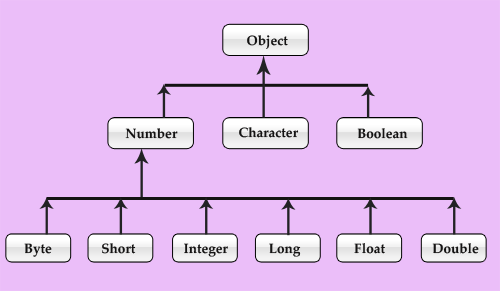Java Wrapper class example explains you the use of various wrapper classes.

Java Wrapper Class Example
In this section we will read about how to use the wrapper classes in Java.
Wrapper classes wrap the primitive data types to objects of that class. In Java there are eight primitive data types and each data type has the corresponding wrapper class. These wrapper classes belongs to the java.lang package. In Java the wrapper classes are required to allow the null values because objects can be null whereas, the primitives can't. Wrapper classes are used in to include the values in Collection, it is required for type safety. It is required when treating the primitives values as an object with other objects. The table given below lists the primitive data types and its respective wrapper class :
| Primitive Data Type | Wrapper Class |
|---|---|
| boolean | Boolean |
| byte | Byte |
| char | Character |
| int | Integer |
| float | Float |
| double | Double |
| long | Long |
| short | Short |
Following image demonstrates the hierarchy of the Wrapper class :

Almost all of each wrapper class has the parseXXX(), toString(), xxxxValue() etc. Below we are discussing some of the methods of java.lang.Integer class but, these methods are usually applies on almost all wrapper classes.
| Method Name | Method Description |
|---|---|
| parseInt(String s) | This method is used to parse the String representation of number to signed
decimal integer. Syntax : public static int parseInt(String s) throws NumberFormatException |
| toString() | This method is used to represent an Integer value to a String object. Syntax : public String toString() |
| valueOf(String s) | This method is used to represent the value of String as an Integer object. Syntax : public static Integer valueOf(String s) throws NumberFormatException |
| equals(Object obj) | This method is used to compare the object with the specified object whether
they are equals or not. Syntax : public boolean equals(Object obj) |
| hashCode() | This method is used to find the hash code of the Integer. Syntax : public int hashCode() |
| compareTo(Integer anotherInteger) | This method is used to compare two Integers. It returns 0 (zero) if the
values are equal, returns negative value if the specified object value is
greater than the invoking object vlaue, returns positive value if the specified
object value is lower than the invoking object value. Syntax : public int compareTo(Integer anotherInteger) |
| compareTo(Object o) | This method is used to compare the Integer object to another object. Syntax : public int compareTo(Object o) |
Example
Here I am giving a simple example which will demonstrate you about how to use the wrapper classes in Java. In this example we will create a Java class where we will use the various methods of java.lang.Integer class such as compareTo(), equal(), toString() etc.
WrapperClassExample.java
package net.roseindia.wrapperclassexample;
public class WrapperClassExample {
public static void main(String args[])
{
String num = "20";
int i = Integer.parseInt(num);
Integer it1 = new Integer(num);
Integer it2 = new Integer(20);
String str = it2.toString();
Integer intstr = Integer.valueOf(str);
boolean bol = it1.equals(i);
int c = it2.compareTo(intstr);
if(c == 0)
{
System.out.println("it2 and intstr are equals");
}
System.out.println("String representation of it2 = "+ str);
System.out.println("Integer object = "+ it1);
System.out.println("Integer representation of num = "+i);
System.out.println("it1 and i are equal : "+bol);
}
}
Output
When you will compile and execute the above example you will get the output as follows :

